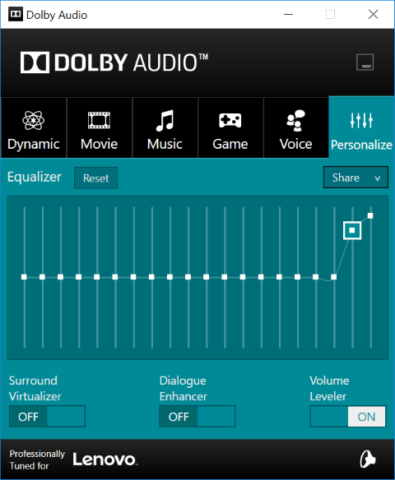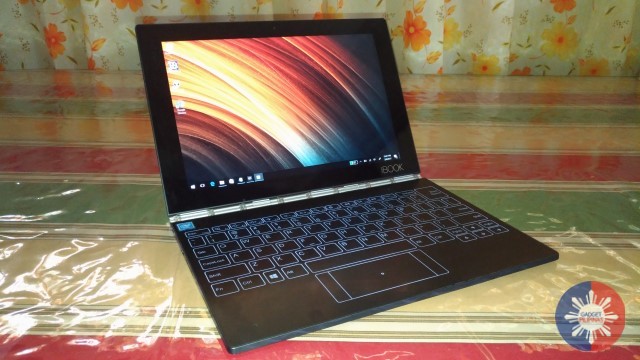Everytime i come across a two-in-one device such as the Lenovo Yoga Book, one question always pops in my mind. Does it really make sense to have something like this with you? Can something like this be really good in being a laptop and being a tablet at the same time? Or is it another jack of all trades: good at everything but excels with nothing?
Fortunately, we got our hands on a review unit of the Yoga Book YB1-X91F, which features an extremely compact form factor, a 10.1-inch touchscreen display, and seemingly capable specs. So decided to find out for myself, what makes this device tick?
Packaging Done Right

The Yoga Book doesn’t just come in an ordinary brown box, but in a fancy white box with branding all over it.

One look and you’ll know that there’s something quite special inside, and the company was actually generous enough to include exclusive papers that can be used on top of the drawing pad’s surface, and an actual pen apart from the usual accessories.
The Yoga Book itself is wrapped in a film, with another sheet covering the keyboard/drawing pad.
A Sleek and Elegant Design

With an ultra-thin form factor and weighing just 1.4 kilograms, the Yoga Book reminds me of an organizer with a leather cover: formal, elegant, classy. The matte surface complements the entire design, along with the metal hinges, and the Lenovo branding.
 You’ll find the speaker, headphone jack, power button, and volume rocker on the right side, while the left side houses a Card Reader, a Mini HDMI port, and a MicroUSB port for charging the device, as well as connecting any accessories or other device.
You’ll find the speaker, headphone jack, power button, and volume rocker on the right side, while the left side houses a Card Reader, a Mini HDMI port, and a MicroUSB port for charging the device, as well as connecting any accessories or other device.

It also has 2 cameras, an 8MP main camera, and a 2MP secondary camera. One thing that makes the Yoga Book Unique is its Halo Keyboard, which is basically a flat surface with illuminated keys that in a touch of a button, turns into a drawing pad. Yes, it comes with a pen.
Easy to Carry Around, But There’s a Catch

I’m not fond of using touchpads on laptops, and always makes it a point to use a wireless mouse. But only having a single port for basically any accessory or device you’d want to connect, I have to have an OTG cable to make it work. And no, the package doesn’t come with one.
And when the time comes that you have to charge the device, you have to remove whatever is connected in that MicroUSB port for the charger, and stick to the touchpad. Of course, you may use a hub which allows you to connect multiple USB devices, but that again, is another accessory that you have to get seperately.
I’m sure at this time, you’re already getting my point. This thing, while easy to carry around, brings a lot of hassle when it comes to connecting accessories and other devices. Why not include even one standard USB 3.0 port? A few millimeters of added thickness is more than acceptable in exchange for the convenience.
A Decent Display

The Yoga Book’s 10.1-inch Full HD touchscreen is suprsingly underwhelming. It’s not as bright as what I expected it to be, and a little more sharpness would’ve been nice. It’s still vibrant enough for me to enjoy the viewing experience though.
Underwhelming Performance
Lenovo Yoga Book (YB1-X91F) Specs:
- 5GHz Intel Atom X5 Z8550 Processor
- Intel HD Graphics 400
- 4GB of DDR3 RAM, 64 GB of Internal Storage
- 1-inch Full HD IPS Touch Screen Display
- 8MP Main Camera, 5MP Secondary Camera
- Ports: 1 x MicroUSB, 1 x Mini HDMI, Card Reader
- Windows 10 Pro
- 8500 mAh Li-Po Battery

As you can see, the Yoga Book doesn’t exactly have the most powerful hardware to boot. And while it generally performed as expected on basic tasks (watching videos, editing documents, browsing the web, etc.), I did encounter some lag and delays in response when opening certain apps, as well as when multi-tasking. Bootup time was also inconsistent.

And it’s even worse when installing applications. Believe it or not, I even encountered slight delays in opening the Start menu. Sometimes, the touch pad won’t even respond.
In Tablet Mode though, the browsing experience was more than satisfactory, as the touch screen was responsive and accurate for most of the time.
A Beautiful and Unfamiliar Keyboard

I do understand that the purpose of having a flat surface as a keyboard is to accommodate the feature of being able to draw on it at the same time. But, i found myself having a hard time using it.
A normal keyboard would give your hands a feel of which buttons you are pressing, like even without looking, you know that the letter H is below the letter T, because the feedback gives you a sense of where the keys are.
But in this, the only feedback you get is a vibration. Perhaps it just takes a bit of getting used to, but I can already see some people having a problem with it.
The Drawing Pad Works, and Its Fun to Use


Whether for drawing a portrait, or just for taking notes, the Yoga Book’s drawing pad is brilliant piece of hardware. The pen input was accurate, even when I was moving the pen quickly across the surface. If you want to take quick sketches or perhaps a simple picture message, or if you are just too frustrated with using the keyboard, then this feature will work well for you.
When the Touchpad Makes Things Harder

The lack of a double tap and drag capability only adds to the hassle when using the touchpad. It means that you have to tap and hold left click button, tap, and then drag. Now, you can actually do this with one hand, but really, why make it complicated?
There were also times when it was frustratingly unresponsive. I’m not sure if it has something to do with the processing package, but it was really annoying especially when copying files, or clicking items on the start menu.
Immersive Sound

The Yoga Book only has a single speaker located at the right side. But it’s equipped with Dolby Atmos capability for improving the sound quality. And it does work. There’s no distortion at high volume, and the clarity is mesmerizing. It’s even better with headphones on, because you can clearly hear the bass kicking in, just right, and not overpowering.
The Dolby Audio app even lets you tweak the sound to your liking with an equalizer, or by using the available presets. The music preset should be good for most genres though.
Good Software with Mediocre Hardware

The Yoga Book runs on Windows 10 Home, and surprisingly, there’s no bloatware to worry about. So you’ll probably be getting max performance from the get go. But then again, the processing package isn’t that great, so installing your apps from scratch, well… let’s just say you’ll need some patience.
Good Battery Life

We played a video on loop at 50% brightness and 80% volume, and the Yoga Book was able to yield around 10 hours of uptime, which is excellent for a device this thin and compact. Charging ranges from 2.5 to 3 hours, which is quite a wait, but considering how big the battery on this thing is, i’d say that is acceptable.
Verdict
The Lenovo Yoga Book will do a good job as a basic assistant for day to day tasks. It has excellent build quality, a decent and responsive touch screen display, offers an immersive listening experience, and great battery life.
It does have many things that can be improved on: The design could use a revamp in the form of an additional USB port, the touchpad just makes things harder, and the processing package just isn’t up to par. This is something that you can bring to a classroom or a meeting to take notes and quick sketches, perhaps even to record lectures, but it’s certainly not for demanding tasks such as photo or video editing.
Now this would’ve made sense if the price was good, but for roughly PhP29,000? It’s extremely hard to recommend it, unless you’re a fan of the brand, or you just happen to have the money to spare.
The Good
- Build Quality
- Display
- Touch Responsiveness
- Battery Life
- No Bloatware
- Compact Form Factor
The Not So Good
- General Performance due to mediocre hardware
- Design (No USB 3.0 port)
- Touchpad
- Price
Emman has been writing technical and feature articles since 2010. Prior to this, he became one of the instructors at Asia Pacific College in 2008, and eventually landed a job as Business Analyst and Technical Writer at Integrated Open Source Solutions for almost 3 years.







